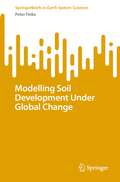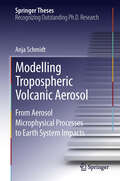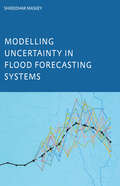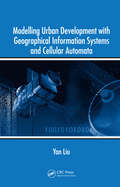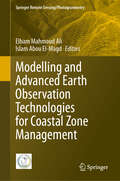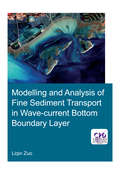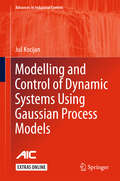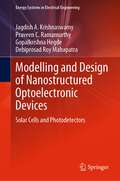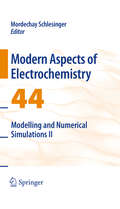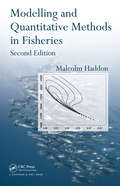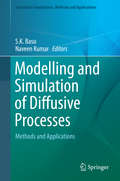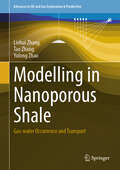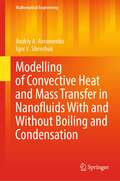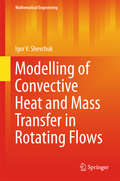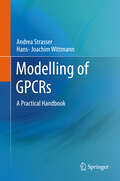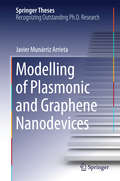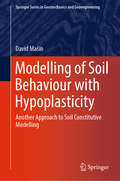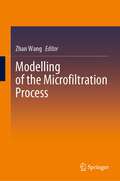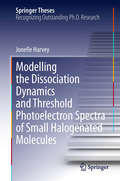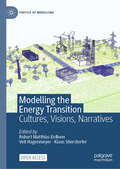- Table View
- List View
Modelling Soil Development Under Global Change (SpringerBriefs in Earth System Sciences)
by Peter FinkeQuantitative assessments of the effects of global change on soil development are mostly focused on soil carbon, some nutrients, pollutants and soil water. Soil however is a complex entity with interacting biological, physical and chemical processes that are rarely modelled in its entirety. Additionally, for the sake of simplicity various soil properties are considered constants whereas in reality they are not. Soil as we observe it is the resultant of many processes driven by varying boundary conditions such as climate and organisms including men. This is not different when we study global change, thus modelling soil development under global change overlaps with modelling soil formation. This book gives an overview of what such model should entail, with ample descriptions to use SoilGen, a simulattion model to study pedogenesis.
Modelling Tropospheric Volcanic Aerosol
by Anja SchmidtAnja Schmidt's thesis is a unique and comprehensive evaluation of the impacts of tropospheric volcanic aerosol on the atmosphere, climate, air quality and human health. Using a state-of-the-art global microphysics model, the thesis describes and quantifies the impact of volcanic sulphur emissions on global aerosol, clouds and the radiative forcing of climate. The advanced model enables the first ever estimate of the impact of the emissions on aerosol microphysical properties such as particle number concentrations and sizes, and therefore a considerably improved ability to quantify the climate and air quality effects. There are several important discoveries in this thesis. Firstly, it is shown that continuously degassing volcanoes exert a major effect on global clouds and climate. Secondly, the impact of the 1783 Laki eruption in Iceland is re-examined to show that this long-lasting flood lava eruption would have had major effects on clouds and climate. Thirdly, by combining her research on volcanism, atmospheric science and epidemiology, she shows that a present-day Laki-like eruption would seriously affect European air quality and cause over 100000 premature deaths in the first year.
Modelling Turbulence in Engineering and the Environment
by Kemal Hanjali Brian LaunderModelling transport and mixing by turbulence in complex flows is one of the greatest challenges for CFD. This highly readable volume introduces the reader to a level of modelling that respects the complexity of the physics of turbulent flows - second-moment closure. Following introductory chapters providing essential physical background, the book examines in detail the processes to be modelled, from fluctuating pressure interactions to diffusive transport, from turbulent time and length scales to the handling of the semi-viscous region adjacent to walls. It includes extensive examples ranging from fundamental homogeneous flows to three-dimensional industrial or environmental applications. This book is ideal for CFD users in industry and academia who seek expert guidance on the modelling options available, and for graduate students in physics, applied mathematics and engineering who wish to enter the world of turbulent flow CFD at the advanced level.
Modelling Uncertainty in Flood Forecasting Systems
by Shreedhar MaskeyLike all natural hazards, flooding is a complex and inherently uncertain phenomenon. Despite advances in developing flood forecasting models and techniques, the uncertainty in forecasts remains unavoidable. This uncertainty needs to be acknowledged, and uncertainty estimation in flood forecasting provides a rational basis for risk-based
Modelling Urban Development with Geographical Information Systems and Cellular Automata
by Yan LiuUrban development and migration from rural to urban areas are impacting prime agricultural land and natural landscapes, particularly in the less developed countries. These phenomena will persist and require serious study by those monitoring global environmental change. To address this need, various models have been devised to analyze urbanization a
Modelling and Advanced Earth Observation Technologies for Coastal Zone Management (Springer Remote Sensing/Photogrammetry)
by Elham Mahmoud Ali Islam Abou El-MagdThis volume provides readers with the tools to unlock the potential of Earth observation (EO) technologies to transform coastal zone management. This comprehensive guide delves into how EO technologies can be used monitor and manage coastal areas, emphasizing sustainable land use and development. Designed for researchers, decision-makers, and environmental planners, this book offers multi-scale assessment approaches that provide actionable solutions and strategic plans for managing extensive environmental landscapes. Readers will discover innovative management solutions for a variety of environmental challenges, along with new methodologies aimed at sustainable development and the achievement of the United Nations Sustainable Development Goals (SDGs) and 2030 targets. This volume showcases numerous multi-tasked applications of satellite data from diverse sources, validating the immense value of earth observations in environmental management. By integrating this data into geographical databases, the book provide an ideal framework for spatial planning at various scales. Geospatial information is a crucial tool for creating interactive systems for spatial analysis, merging real-world data with forecasting models to support social and economic development. Geospatial information guides where and when to act, aiding in the development of strategic and implementation plans that promote sustainable development. Embrace the future of coastal zone management with this volume and equip yourself with the knowledge and tools to make informed, impactful decisions for a sustainable tomorrow.
Modelling and Analysis of Fine Sediment Transport in Wave-Current Bottom Boundary Layer (IHE Delft PhD Thesis Series)
by Liqin ZuoThe evolution and utilization of estuarine and coastal regions are greatly restricted by sediment problems. This thesis aims to better understand fine sediment transport under combined action of waves and currents, especially in the wave-current bottom boundary layer (BBL). Field observations, experimental data analysis, theoretical analysis and numerical models are employed. Silt-dominated sediments are sensitive to flow dynamics and the suspended sediment concentration (SSC) increase rapidly under strong flow dynamics. This research unveils several fundamental aspects of silty sediment, i.e., the criterion of the incipient motion, the SSC profiles and their phase-averaged parameterization in wave-dominated conditions. An expression for sediment incipient motion is proposed for silt-sand sediment under combined wave and current conditions. A process based intra-wave 1DV model for flow-sediment dynamics near the bed is developed in combined wave-current conditions. The high concentration layer (HCL) was simulated and sensitivity analysis was carried out by the 1DV model on factors that impact the SSC in the HCL. Finally, based on the 1DV model, the formulations of the mean SSC profile of silt-sand sediments in wave conditions were proposed. The developed approaches are expected to be applied in engineering practice and further simulation.
Modelling and Control of Dynamic Systems Using Gaussian Process Models
by Juš KocijanThis monograph opens up new horizons for engineers and researchers inacademia and in industry dealing with or interested in new developments in thefield of system identification and control. It emphasizes guidelines forworking solutions and practical advice for their implementation rather than thetheoretical background of Gaussian process (GP) models. The book demonstratesthe potential of this recent development in probabilistic machine-learningmethods and gives the reader an intuitive understanding of the topic. Thecurrent state of the art is treated along with possible future directions forresearch. Systems control design relies on mathematical models and these may bedeveloped from measurement data. This process of system identification, whenbased on GP models, can play an integral part of control design in data-basedcontrol and its description as such is an essential aspect of the text. Thebackground of GP regression is introduced first with system identification andincorporation of prior knowledge then leading into full-blown control. The bookis illustrated by extensive use of examples, line drawings, and graphicalpresentation of computer-simulation results and plant measurements. Theresearch results presented are applied in real-life case studies drawn fromsuccessful applications including: a gas-liquid separator control; urban-traffic signal modelling and reconstruction; and prediction of atmospheric ozone concentration. A MATLAB® toolbox, for identification and simulation ofdynamic GP models is provided for download.
Modelling and Controlling Hydropower Plants
by Sa'Ad Petrous Mansoor German Ardul Munoz-Hernandez Dewi Ieuan JonesHydroelectric power stations are a major source of electricity around the world; understanding their dynamics is crucial to achieving good performance. The electrical power generated is normally controlled by individual feedback loops on each unit. The reference input to the power loop is the grid frequency deviation from its set point, thus structuring an external frequency control loop. The book discusses practical and well-documented cases of modelling and controlling hydropower stations, focused on a pumped storage scheme based in Dinorwig, North Wales. These accounts are valuable to specialist control engineers who are working in this industry. In addition, the theoretical treatment of modern and classic controllers will be useful for graduate and final year undergraduate engineering students. This book reviews SISO and MIMO models, which cover the linear and nonlinear characteristics of pumped storage hydroelectric power stations. The most important dynamic features are discussed. The verification of these models by hardware in the loop simulation is described. To show how the performance of a pumped storage hydroelectric power station can be improved, classical and modern controllers are applied to simulated models of Dinorwig power plant, that include PID, Fuzzy approximation, Feed-Forward and Model Based Predictive Control with linear and hybrid prediction models.
Modelling and Design of Nanostructured Optoelectronic Devices: Solar Cells and Photodetectors (Energy Systems in Electrical Engineering)
by Jagdish A. Krishnaswamy Praveen C. Ramamurthy Gopalkrishna Hegde Debiprosad Roy MahapatraThis book approaches the design of functionally superior optoelectronic devices through the use of bio-inspired nanostructures and multiscale material structures through a step-by-step approach. The book combines both the fundamental theoretical concepts involved in understanding and numerically modelling optoelectronic devices and the application of such methods in addressing challenging research problems in nanostructured optoelectronic design and fabrication. The book offers comprehensive content in optoelectronic materials and engineering and can be used as a reference material by researchers in nanostructured optoelectronic design.
Modelling and Numerical Simulations II
by Mordechay SchlesingerThis volume is meant as an introductory resource aimed at practitioners of electrochemistry research, technology, and development mainly at the atomic, molecular or macromolecular levels. Thus emphasis is placed at length scales in the 1-100 nm range. The volume will help provide understanding of electrochemical phenomena and materials at the nanoscale through modeling and numeric simulations. It also serves as a means to create and use structures, electrochemically based devices, and systems that possess novel properties and functions because of their small or intermediate sizes.
Modelling and Observation of Exhaust Gas Concentrations for Diesel Engine Control
by Dr Ing. David Blanco-RodriguezThe book presents a complete new methodology for the on-board measurements and modeling of gas concentrations in turbocharged diesel engines. It provides the readers with a comprehensive review of the state-of-art in NOx and lambda estimation and describes new important achievements accomplished by the author. These include: the online characterization of lambda and NOx sensors; the development of control-oriented models of lambda and NOx emissions; the design of computationally efficient updating algorithms; and, finally, the application and evaluation of the methods on-board. Because of its technically oriented approach and innovative findings on both control-oriented algorithms and virtual sensing and observation, this book offers a practice-oriented guide for students, researchers and professionals working in the field of control and information engineering.
Modelling and Optimization of Wave Energy Converters
by Dezhi Ning Boyin DingWave energy offers a promising renewable energy source. This guide presents numerical modelling and optimisation methods for the development of wave energy converter technologies, from principles to applications. It covers oscillating water column technologies, theoretical wave power absorption, heaving point absorbers in single and multi-mode degrees of freedom, and the relatively hitherto unexplored topic of wave energy harvesting farms. It can be used as a specialist student textbook as well as a reference book for the design of wave energy harvesting systems, across a broad range of disciplines, including renewable energy, marine engineering, infrastructure engineering, hydrodynamics, ocean science, and mechatronics engineering. The Open Access version of this book, available at https://www.routledge.com/ has been made available under a Creative Commons Attribution-Non Commercial-No Derivatives 4.0 license.
Modelling and Quantitative Methods in Fisheries
by Malcolm HaddonWith numerous real-world examples, Modelling and Quantitative Methods in Fisheries, Second Edition provides an introduction to the analytical methods used by fisheries' scientists and ecologists. By following the examples using Excel, readers see the nuts and bolts of how the methods work and better understand the underlying principles. Excel workb
Modelling and Simulation in Plasma Physics for Physicists and Mathematicians
by Geoffrey J. PertUnveiling the Secrets of Plasma Physics: A Practical Guide to Computational Simulations Plasma physics focuses on the most abundant state of matter in the universe, corresponding to ionized gas comprising ions and electrons. It can be created artificially and has a huge range of technological applications, from television displays to fusion energy research. Every application of plasma technology requires its own numerical solution to the complex physical and mathematical equations which govern the research field of plasma physics. Modelling and Simulation in Plasma Physics for Physicists and Mathematics offers an introduction to the principles of simulating plasma physics applications. It provides knowledge not only of the fundamental algorithms in computational fluid mechanics, but also their specific role in a plasma physics context. In addition, the book dissects the challenges and advancements, unveiling the delicate balance between accuracy and computational cost. Modelling and Simulation in Plasma Physics for Physicists and Mathematics readers will also find: Cutting-edge computational insights where powerful simulations meet theoretical complexities, providing physicists and mathematicians a gateway to cutting-edge research. An overview of programming language-agnostic code generation and the construction of adaptable models that resonate with the intricate dynamics of plasma physics, ensuring precision in every simulation. Advanced simplification strategies, including time splitting, analytic models, averaged rates, and tabular material, offering scientists and engineers a roadmap to balance computational demands with scientific rigor. Modelling and Simulation in Plasma Physics for Physicists and Mathematics is ideal for plasma physicists, students, and engineers looking to work with plasma technologies.
Modelling and Simulation of Diffusive Processes
by Naveen Kumar S. K. BasuThis book addresses the key issues in the modeling and simulation of diffusive processes from a wide spectrum of different applications across a broad range of disciplines. Features: discusses diffusion and molecular transport in living cells and suspended sediment in open channels; examines the modeling of peristaltic transport of nanofluids, and isotachophoretic separation of ionic samples in microfluidics; reviews thermal characterization of non-homogeneous media and scale-dependent porous dispersion resulting from velocity fluctuations; describes the modeling of nitrogen fate and transport at the sediment-water interface and groundwater flow in unconfined aquifers; investigates two-dimensional solute transport from a varying pulse type point source and futile cycles in metabolic flux modeling; studies contaminant concentration prediction along unsteady groundwater flow and modeling synovial fluid flow in human joints; explores the modeling of soil organic carbon and crop growth simulation.
Modelling in Nanoporous Shale: Gas-water Occurrence and Transport (Advances in Oil and Gas Exploration & Production)
by Tao Zhang Liehui Zhang Yulong ZhaoThis book addresses the problems involved in the modelling and simulation of shale gas reservoirs at pore scale, and details recent advances in the field. It presents the construction of simulation methods, mainly using the lattice Boltzmann method (LBM), that describe sorption, flow, and transport in nanoporous shale with some case studies. This book highlights the nanoscale effects, ascribed to the large surface-to-volume ratio, on fluids occurrence and transport physics. It discusses some interesting phenomena occurs at nanoporous shale, such as absorbed water film, water condensation, sorption hysteresis, surface excess adsorption, Knudsen diffusion, surface diffusion, structural fluid density, no-slip boundary, etc. The key techniques and methods introduced in this book provide the basis for accurate prediction of gas-well productivity. The basic principles and modeling methods are also relevant to many other nanoporous applications in science and engineering. The book aims to provide a valuable reference resource for researchers and professional scientists and engineers working on shale gas development and nanoporous media research.
Modelling of Convective Heat and Mass Transfer in Nanofluids with and without Boiling and Condensation (Mathematical Engineering)
by Igor V. Shevchuk Andriy A. AvramenkoThis book presents step-by-step description of the use of Lie group analysis to find symmetry forms and similarity solutions for single- and two-phase laminar and turbulent flows of nanofluids. It outlines novel and unique analytical solutions validated via comparisons with experimental data. The main part of the book is devoted to analytical modeling of film condensation of still and moving vapor with nanoparticles, stable film boiling of nanofluids, instantaneous unsteady boiling and condensation of nano- and ordinary fluids and clarification and quantification of instability conditions in the vapor layer, as well as centrifugal and Dean instability in nanofluids. It was demonstrated that such complex phenomena can be successfully simulated using the proposed approaches validated via reliable experiments. The book is intended for scientists, engineers, graduate and undergraduate students specializing in the area of engineering thermodynamics, heat and mass transfer and energy systems.
Modelling of Convective Heat and Mass Transfer in Rotating Flows
by Igor V. ShevchukThis monograph presents results of the analytical and numerical modeling of convective heat and mass transfer in different rotating flows caused by (i) system rotation, (ii) swirl flows due to swirl generators, and (iii) surface curvature in turns and bends. Volume forces (i. e. centrifugal and Coriolis forces), which influence the flow pattern, emerge in all of these rotating flows. The main part of this work deals with rotating flows caused by system rotation, which includes several rotating-disk configurations and straight pipes rotating about a parallel axis. Swirl flows are studied in some of the configurations mentioned above. Curvilinear flows are investigated in different geometries of two-pass ribbed and smooth channels with 180° bends. The author demonstrates that the complex phenomena of fluid flow and convective heat transfer in rotating flows can be successfully simulated using not only the universal CFD methodology, but in certain cases by means of the integral methods, self-similar and analytical solutions. The book will be a valuable read for research experts and practitioners in the field of heat and mass transfer.
Modelling of GPCRs
by Andrea Strasser Hans-Joachim WittmannG protein coupled receptors (GPCRs) comprise an important protein family, which is involved in signal transduction in the cell. Besides that a large number of drugs, available on market, address GPCRs. For an efficient and improved development of appropriate drugs, molecular modelling of GPCRs is - in order to understand the ligand-receptor interactions and functionality of GPCRs on molecular level - an important tool. The book "Modelling of GPCRs - a practical handbook" is focussed onto a practical introduction into molecular modelling of GPCRs. This book is very useful for beginners in GPCR modelling, but also addresses the advanced GPCR modeller: On the one hand, the book introduces principles of GPCR modelling, including extensive examples. On the other hand, detailed outlooks onto advanced GPCR modelling techniques are presented. Furthermore, the book includes important data, like information about crystal structures in a summarized manner or amino acid sequences, which are essential for GPCR modelling in general. Due to an increase in efficacy and data handling most modellers use LINUX as operating system. To address this, a summary of most important LINUX commands with examples is presented within the book.
Modelling of Plasmonic and Graphene Nanodevices
by Javier Munárriz ArrietaThe thesis covers a broad range of electronic, optical and opto-electronic devices and various predicted physical effects. In particular, it examines the quantum interference transistor effect in graphene nanorings; tunable spin-filtering and spin-dependent negative differential resistance in composite heterostructures based on graphene and ferromagnetic materials; optical and novel electro-optical bistability and hysteresis in compound systems and the real-time control of radiation patterns of optical nanoantennas. The direction of the main radiation lobe of a regular plasmonic array can be changed abruptly by small variations in external control parameters. This optical effect, apart from its relevance for applications, is a revealing example of the Umklapp process and, thus, is a visual manifestation of one of the most fundamental laws of solid state physics: the conservation of the quasi-momentum to within a reciprocal lattice vector. The thesis analyzes not only results for particular device designs but also a variety of advanced numerical methods which are extended by the author and described in detail. These methods can be used as a sound starting point for further research.
Modelling of Soil Behaviour with Hypoplasticity: Another Approach to Soil Constitutive Modelling (Springer Series in Geomechanics and Geoengineering)
by David Mašín<p>This book explains the hypoplastic modelling framework. It is divided into two parts, the first of which is devoted to principles of hypoplasticity. First, the basic features of soil’s mechanical behaviour are introduced, namely non-linearity and asymptotic properties. These features are then incorporated into simple one-dimensional hypoplastic equations for compression and shear. Subsequently, a hypoplastic equivalent of the Modified Cam-Clay model is developed in 2D space using stress and strain invariants to demonstrate key similarities and differences between elasto-plastic and hypoplastic formulations. Lastly, the mathematical structure of hypoplastic models is explained by tracing their historical development, from the early trial-and-error models to more recent approaches. In turn, Part II introduces specific hypoplastic models for soils. First, two reference models for sand and clay are defined. After summarising their mathematical formulations, calibration procedures are described and discussed. Subsequently, more advanced modelling approaches are covered: the intergranular strain concept incorporating the effects of small strain stiffness and cyclic loading, viscohypoplasticity for predicting rate effects, soil structure to represent structured and bonded materials and soil anisotropy. The book concludes with a description of partial saturation and thermal effects: topics that are increasingly important to the disciplines of energy and environmental geotechnics. <p>Selecting a constitutive model and its parameters is often the most important and yet challenging part of any numerical analysis in geotechnical engineering. Hypoplasticity involves a specific class of soil constitutive models, which are described in detail here. The book offers an essential resource, both for model users who need a more advanced model for their geotechnical calculations and are mainly interested in parameter calibration procedures, and for model developers who are seeking a comprehensive understanding of the mathematical structure of hypoplasticity.</p>
Modelling of the Microfiltration Process
by Zhan WangThis book presents the editor's recently proposed mathematical models for flux prediction in membrane filtration. It also provides typical mathematical models used in the development of membrane fouling control and explains the step-by-step derivation of these models. The book then highlights how these mathematical models provide insights into the mechanisms of membrane fouling and cleaning to allow for a better understanding of the complete membrane filtration process. Given its scope, this book appeals to a broad readership, particularly professionals at universities as well as engineers engaged in membrane separation in an industrial process.
Modelling the Dissociation Dynamics and Threshold Photoelectron Spectra of Small Halogenated Molecules
by Jonelle HarveyJonelle Harvey's book outlines two related experimental techniques, threshold photoelectron spectroscopy and threshold photoelectron photoion coincidence techniques, which are utilised to investigate small halogenated molecules. All the experiments were conducted at the vacuum ultraviolet beamline of the Swiss Light Source, a synchrotron photon source, which has the advantage over popular laser photon-sources of extreme ease of tunability. Three studies are presented which combine experimental and computational ab initio approaches: studying the fast dissociations of halogenated methanes in order to construct a self-consistent thermochemical network; investigating the fragmentations of fluoroethenes from timebombs, which break apart very slowly but explosively, to fast dissociators; and uncovering how vital conical interactions underpin both the results of photoelectron spectra and dissociation patterns. The details included in this thesis are useful for researchers working in the same field and those readers wishing to obtain a solid introduction into the types of systems encountered in threshold photoelectron photoion coincidence spectroscopy.
Modelling the Energy Transition: Cultures, Visions, Narratives (Poetics of Modelling)
by Klaus Stierstorfer Robert Matthias Erdbeer Veit HagenmeyerThis open access book reconfigures Energy Transition as a global discourse from a multidisciplinary perspective. Energy Transition is not only one of the most daring technological endeavours of the present, it is also its new master narrative. Focusing on modelling both as a cultural technique and as a strategy of innovation, the chapters provided in this volume throw into relief the visions, but also the blind spots of modelling the challenges of climate change. Thus, in a rare encounter, major voices from the Sciences and the Humanities, from Energy Systems Design, Mechanical Engineering, Theory of Science, Science and Technology Studies, Literary Studies and the Arts, have gathered here to overcome the cultural divide between the technological and the societal dimensions of this global task. In doing so, they offer a new form of model criticism, pointing to the impacts of what may be termed the ‘Energy Imaginary’ on the technosocial mindsets of our time.
